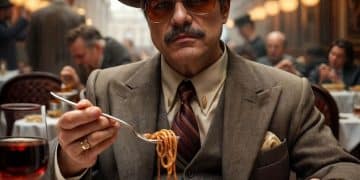The Anti-Hero’s Journey: Unpacking the Moral Ambiguity of ‘The Friends of Eddie Coyle’

The Anti-Hero’s Journey: Unpacking the Moral Ambiguity of ‘The Friends of Eddie Coyle’ (1973) reveals a gritty narrative devoid of traditional heroism, exploring moral compromises and the harsh realities faced by characters in a bleak, crime-ridden world.
Dive into the morally ambiguous world of George V. Higgins’ ‘The Friends of Eddie Coyle’ (1973). This isn’t your typical hero’s tale; it’s a stark portrayal of survival where moral lines blur and choices carry heavy consequences. Let’s explore The Anti-Hero’s Journey: Unpacking the Moral Ambiguity of ‘The Friends of Eddie Coyle’ (1973).
How does this forgotten masterpiece challenge our conventional understanding of heroism? Join us as we dissect the narratives of desperation and moral compromise within this compelling crime novel.
Exploring The Anti-Hero’s Journey in ‘The Friends of Eddie Coyle’
George V. Higgins’ novel, ‘The Friends of Eddie Coyle’, stands as a powerful example of crime fiction that eschews traditional heroic narratives. Instead, it offers a raw and unflinching look at characters operating in a moral gray area.
The Absence of Traditional Heroism
In traditional narratives, heroes often embody virtues such as courage, selflessness, and integrity. However, in ‘The Friends of Eddie Coyle’, these qualities are conspicuously absent.
- Eddie Coyle, the protagonist, is a low-level gun runner desperate to avoid another prison sentence.
- The other characters, including Dillon and the police, are equally compromised, driven by self-interest and survival.
- This absence of conventional heroism forces readers to confront the unsettling reality of moral ambiguity.
The novel’s strength lies in its ability to depict characters who are neither wholly good nor entirely evil, but rather complex individuals shaped by their circumstances.

Moral Ambiguity as a Central Theme
Moral ambiguity is one of the most significant themes in ‘The Friends of Eddie Coyle’. The characters often make decisions that are morally questionable, blurring the lines between right and wrong.
- Eddie Coyle’s willingness to inform on others to save himself exemplifies this ambiguity.
- The police, while ostensibly upholding the law, engage in manipulative tactics to secure convictions.
- This thematic focus challenges readers to question their own moral compass and consider the complexities of human behavior.
By embracing moral ambiguity, Higgins creates a world that feels authentic and relatable, even though it is populated by criminals and compromised individuals.
In conclusion, ‘The Friends of Eddie Coyle’ offers a compelling exploration of the anti-hero’s journey by presenting characters who lack traditional heroic qualities and navigate a world rife with moral compromises, making The Anti-Hero’s Journey: Unpacking the Moral Ambiguity of ‘The Friends of Eddie Coyle’ (1973) a seminal work in crime fiction.
The Gray Areas of Justice and Law Enforcement
In ‘The Friends of Eddie Coyle’, the portrayal of law enforcement is far from idealized. Instead of presenting officers as paragons of justice, Higgins depicts them as individuals who operate within their own moral compromises.
Ethical Compromises in Policing
The police officers in the novel often resort to questionable tactics to achieve their goals. They pressure informants, manipulate suspects, and sometimes bend the rules to secure convictions.
For example, the character of Dillon, who works as an informant, is constantly navigating the treacherous waters of loyalty and self-preservation. His actions are driven by a desire to stay alive and out of prison, leading him to make morally ambiguous choices.
The Impact on the Characters
The moral compromises made by both the criminals and the law enforcement officers have a profound impact on their lives.
- Eddie Coyle’s desperation leads him to make increasingly risky decisions.
- Dillon’s duplicity erodes his sense of self and isolates him from genuine human connection.
- The police officers, while achieving a sense of professional success, are haunted by the ethical compromises they have made.
‘The Friends of Eddie Coyle’ does not offer easy answers or moral judgments. Instead, it invites readers to consider the complex interplay between justice, law enforcement, and human nature.

Ultimately, the exploration of gray areas in justice and law enforcement is a critical element of The Anti-Hero’s Journey: Unpacking the Moral Ambiguity of ‘The Friends of Eddie Coyle’ (1973), offering a nuanced perspective on the complexities of morality in a world defined by crime and survival.
Character-Driven Narrative: Beyond Good and Evil
‘The Friends of Eddie Coyle’ distinguishes itself through its character-driven narrative. The lives and decisions of the characters propel the story forward, offering insights into their motivations, fears, and moral boundaries.
Eddie Coyle: A Study in Desperation
Eddie Coyle is not a typical protagonist. He is a flawed, desperate man caught in a web of his own making.
His motivations are simple: to avoid going back to prison and to provide for his family. However, his choices are far from straightforward, leading him down a path of moral compromise and ultimately, tragedy.
The Supporting Cast
The supporting characters in ‘The Friends of Eddie Coyle’ are equally well-developed, each with their own motivations and moral ambiguities.
- Dillon, the informant, is a complex character who is both victim and perpetrator.
- The police officers are portrayed as pragmatic individuals who are willing to bend the rules to achieve their goals.
- These characters add depth and complexity to the narrative, illustrating that no one is purely good or purely evil.
By focusing on the characters and their internal struggles, Higgins creates a narrative that is both compelling and thought-provoking.
In essence, the character-driven narrative underscores the themes present in The Anti-Hero’s Journey: Unpacking the Moral Ambiguity of ‘The Friends of Eddie Coyle’ (1973). By delving deep into the motivations of each character, this complexity further shows the difficult decisions each criminal must make.
The Impact of Realism on the Narrative
One of the defining features of ‘The Friends of Eddie Coyle’ is its unflinching realism. Higgins’ portrayal of the criminal underworld is devoid of glamour or romanticism, offering a stark and unvarnished look at the lives of those involved.
Authenticity in Dialogue and Setting
Higgins’ background as a lawyer allowed him to bring an unparalleled level of authenticity to his writing. The dialogue in ‘The Friends of Eddie Coyle’ is gritty and realistic, capturing the language and rhythms of the criminal underworld.
The setting, a bleak and unforgiving urban landscape, further enhances the sense of realism. There are no idealized locations or romanticized characters; instead, the novel presents a world that is harsh, unforgiving, and morally compromised.
Emotional Resonance
The realism of ‘The Friends of Eddie Coyle’ extends beyond its dialogue and setting. The novel also resonates emotionally, capturing the sense of desperation, fear, and moral ambiguity that permeates the lives of its characters.
- Eddie Coyle’s struggles to avoid prison are palpable, evoking a sense of empathy in the reader.
- The moral compromises made by the characters are presented without judgment, allowing readers to grapple with the complexities of their choices.
- This emotional resonance is what makes ‘The Friends of Eddie Coyle’ a truly memorable and impactful work of literature.
The impact of realism on the storyline of The Anti-Hero’s Journey: Unpacking the Moral Ambiguity of ‘The Friends of Eddie Coyle’ (1973) is undeniable. This unflinching reflection into the criminal underbelly leaves an enduring impact on its readers.
Why ‘The Friends of Eddie Coyle’ Remains Relevant
Despite being published in 1970, ‘The Friends of Eddie Coyle’ continues to resonate with modern readers. Its exploration of moral ambiguity and character portrayal are timeless themes.
Timeless Themes
The themes explored in ‘The Friends of Eddie Coyle’ – moral compromise, desperation, and the complexities of human nature – are as relevant today as they were in the 1970s.
The novel’s portrayal of law enforcement, with its ethical gray areas, continues to spark debate and discussion. Its unflinching look at the criminal underworld remains both compelling and unsettling.
Influence on Later Works
‘The Friends of Eddie Coyle’ has had a profound influence on later works of crime fiction, inspiring a generation of writers to explore the darker corners of human experience.
- Its realistic dialogue and character-driven narrative have become hallmarks of the genre.
- Its exploration of moral ambiguity and ethical compromise has paved the way for more complex and nuanced portrayals of criminals and law enforcement officers.
- As a result, ‘The Friends of Eddie Coyle’ has secured its place as a classic of crime literature.
The enduring relevance of ‘The Friends of Eddie Coyle’ lies in its ability to provoke thought, challenge assumptions, and offer a window into the darker aspects of the human condition, furthering the themes of The Anti-Hero’s Journey: Unpacking the Moral Ambiguity of ‘The Friends of Eddie Coyle’ (1973).
Deconstructing the Narrative Structure
The narrative structure in ‘The Friends of Eddie Coyle’ is unique and deliberate. Let’s unpack why it makes the novel such a compelling read.
Non-Linear Storytelling
Unlike a traditional novel, George V. Higgins employs non-linear storytelling. This technique mirrors the chaotic and unpredictable nature of the criminal world Coyle occupies.
This way of telling the story requires the reader to fully piece together the plot and character motivations. It can be challenging, but it increases reader engagement.
Shifting Perspectives
The narrative switches between the points of view of various characters. This is one of the ways in which Higgins fleshes out the complex world within ‘The Friends of Eddie Coyle’.
- Insight into Coyle’s Desperation: Shifting perspectives is a way the author captures the fear coursing through Coyle, and those he associates with.
- Deeper Understanding: The reader gains a deeper understanding of each character’s motivations.
- Increased Tension: We feel on edge as a reader because the story is not as straightforward in relaying the information.
By deconstructing the narrative, the reader becomes even more aware of the implications presented in The Anti-Hero’s Journey: Unpacking the Moral Ambiguity of ‘The Friends of Eddie Coyle’ (1973). The unique format of the storytelling itself illustrates the moral conundrum that each character faces.
| Key Point | Brief Description |
|---|---|
| 🤔 Moral Ambiguity | Characters often make questionable choices. |
| ⚖️ Justice | Law enforcement operates in gray areas. |
| 🔫 Eddie Coyle | A desperate anti-hero caught in a criminal web. |
| 🎭 Realism | Authentic portrayal of the criminal underworld. |
Frequently Asked Questions
Its realistic portrayal of criminals and law enforcement alongside its morally ambiguous themes is the key. The book offers an unvarnished and authentic reading experience that differs from many other novels.
Eddie Coyle is a small-time gunrunner in desperate circumstances working in the criminal underbelly. Trying to avoid another stint in jail motivates most of his questionable actions throughout the plot.
The novel presents an amoral viewpoint in which each character is primarily concerned with self-survival. None of the characters are heroic. The central theme demonstrates the dangers of living in a world without high morals.
The book favors the use of realistic dialogue. As a result, the storytelling brings a high level of authentic and immersive writing to what would otherwise be a one-dimensional tale of criminality.
Yes, this novel has been very influential in the crime genre. George Higgins’ narrative style changed writing for the better by challenging previous assumptions that focused on more clear-cut, simplistic ideas.
Conclusion
‘The Friends of Eddie Coyle’ remains a significant work of crime fiction because of its unflinching realism and moral ambiguity. The characters and their journeys of self-preservation highlight The Anti-Hero’s Journey: Unpacking the Moral Ambiguity of ‘The Friends of Eddie Coyle’ (1973).
The novel offers a powerful and enduring testament to the complexities of human nature and the world of moral compromises.





